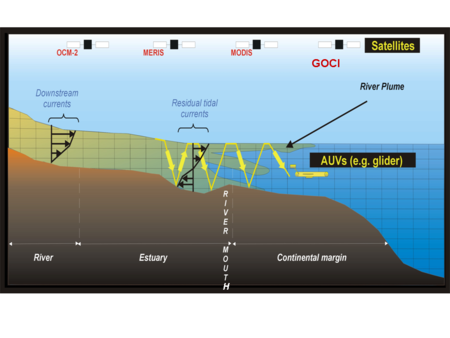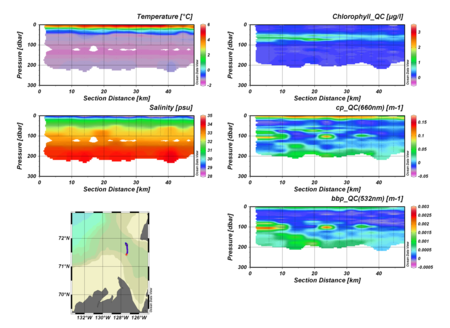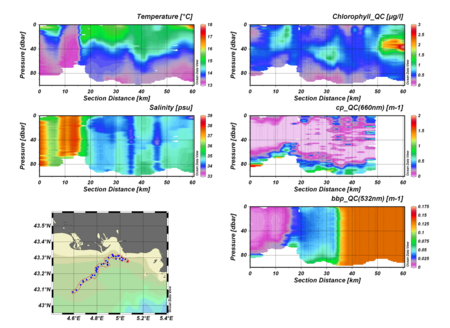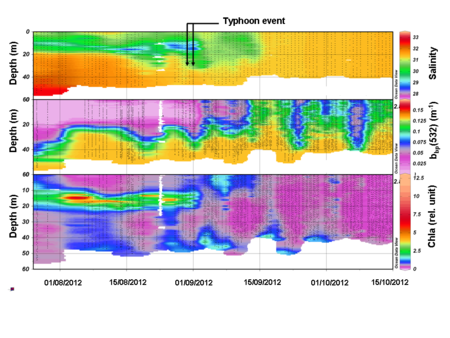The main objective of the PROVPANACHE project is to use physical and bio-optical measurements onboard autonomous profiling floats (ProvBio) to complement satellite observations and study the dynamics of suspended particles in coastals waters directly influenced by river discharges.
PROVPANACHE
by D. Doxaran (1), H.Claustre, M. Babin, T. Lorthiois and A. Poteau (a)
(1) : Corresponding author : David Doxaran, doxaran@obs-vlfr.fr
(a) : UMR 7093, CNRS-UPMC, Laboratoire d’Océanographie de Villefranche, France
Physical and bio-optical measurements carried out onboard autonomous profiling floats are used to study the dynamics of river plumes. The objective is to complement satellite observations limited to surface waters and get information within the water column (thickness of river plumes, nepheloid layers, settling of particles, resuspension phenomena). It is expected to retrieve information on the three-dimensional dynamics of terrestrial substances (such as suspended particles and coloured dissolved organic matter) combining satellite and field autonomous observations.
Scientific Interest
Tracking particles exported by rivers in the coastal ocean and determining the associated fate of the terrestrial organic carbon is made difficult because of complex dynamical processes in these estuarine environments (Dagg et al., 2004; Geyer et al., 2004). The use of ocean color satellite observations, such as MERIS data, only allows monitoring the dynamics of suspended particles within the surface layer (0-2 meters depth) (Doxaran et al. 2002, 2009), while the transport of particles is clearly three-dimensional. Satellite observations must be complemented by field measurements to provide information on the sinking of particles.
Figure 1: Schematic view of a river plume sampled using ocean color satellite and field data recorded by an autonomous profiling vehicle.
The main objective of the PROVPANACHE project is thus first to use the autonomous bio-optical profiling floats (Provbio) to complement satellite observations for the study of the dynamics of suspended particles in coastal waters directly influenced by river discharges (fig.1).
The first challenge is to test the capability of the Provbio floats, originally designed for open ocean waters (Xing et al. 2011), in dynamic and shallow waters. The second challenge is to combine satellite and field measurements in order to develop an operational monitoring system able to document the three-dimensional dynamics of suspended particles in coastal waters. Estuarine dynamical processes of interest, such as mixing of fresh and saline waters, study of vertical structures (such as surface plume and nepheloids), particle sinking and resuspension, will be focused on thanks to daily observations.
Methodology
The design of the Provbio-B floats, chosen for the PROVPANACHE project, was achieved thanks to collaboration between IFREMER, LOV and the KANNAD/NKE french company. This float is based on the Provor-CTS3 float equipped with a CTD sensor and miniaturized optical sensors allowing chlorophyll-a fluorescence, colored dissolved organic matter and particle backscattering coefficients measurements. An assistance for ships and recovery is done by the PROVPANACHE team.
Test sites for deployments of Provbio-B floats have been chosen in the arctic (for the Mackenzie-Canada River), tropical (for the Yangtze-China River) and temperate (for the Gironde and Rhône-France) regions in order to obtain global results. All floats deployments occurred at the beginning of planned oceanographic campaigns. For a robust calibration between the optical and biogeochemical measurements, a systematic cross-calibration is established between the CTD and optical data recorded by the float and those recorded onboard the oceanographic vessel. Simultaneously, water samples are collected onboard the ship in order to determine the concentrations of the colored water constituents. During deployments, the Provbio is profiling daily (one or three profiles a day during daytime), and data are transmitted daily for a real-time data processing and display (http://www.obs-vlfr.fr/OAO/, P.I.: A. Poteau). Match-ups with ocean color satellite data recorded by the MERIS and MODIS-Aqua sensors are systematically identified and displayed on the OAO website.
Main Results
In 2009 and 2010, five deployments and recovery were carried out as part of the PROVPANACHE project (table 1). The first deployment occurred in the Beaufort Sea (Canadian Arctic Ocean), directly influenced by the Mackenzie River discharge, during the Malina oceanographic campaign. One ProvBio float was deployed on 07/08/2009 at the boundary between the Beaufort Sea and Amundsen Gulf. The objective was to study the seaward export of particles and colored dissolved organic matter delivered by the Mackenzie River. After deployment, the float profiled once a day between water surface and 200 m depth, moving north along 40 km up to the limit with floating sea ice. The float was then ordered to stop profiling and moved south within surface waters up to recovery onboard the ice-breaker Amundsen on the 21/08/2009.
In 2012, one Provbio float was deployed in the centre of the East China Sea, a region directly influenced by the discharge of the Yangtze River. This float has recorded daily three vertical profiles of CTD and bio-optical data during a 6-months period (12/07/2012-18/01/2013).
|
|
cruise |
R/V |
PI |
Deployment |
Recovery |
| Beaufort Sea |
Malina |
Amundsen |
M. Babin |
07/08/2009 |
21/08/2009 |
| Gulf of Lions |
Optic-Rhône |
Antédon II |
D. Doxaran |
10/04/2010 28/05/2010 |
26/05/2010 02/07/2010 |
| Bay of Biscay |
CAROLS |
Côtes de la Manche |
G. Reverdin L. Marie |
08/05/2010 03/07/2010 |
02/07/2010 02/08/2010 |
| East China Sea |
GOCICAL |
KORDI |
Y. Park |
12/07/2012 |
- |
Table 1: Oceanographic campaigns for PROVPANACHE project.
Temperature and salinity data recorded in the Beaufort Sea (figure 2) clearly show a constant stratification with fresher and warmer waters within a thin (20 m) surface layer resulting from both the Mackenzie discharge and sea-ice melting (Figure 2). A slightly vanishing deep-chlorophyll maximum is clearly observed at 60 m depth. A thin (0 – 5 m depth) surface layer characterized by high concentrations of suspended solids is identified using as proxies the measured light attenuation and backscattering coefficients, indicating the presence of the Mackenzie river plume (probably in addition to particles originating from melted sea ice). Patches of non-chlorophyllous particles are also located at 100 m and 200m depths (sinking).
Figure 2 : Temperature (°C), salinity and bio- optical profiles (chlorophyll-a in µg/l, beam attenuation coefficient at 660 nm (cp) in m-1, particulate backscattering coefficient at 555 nm (bbp) in m-1) recorded by the ProvBio float between surface water and 200 m-depth in the Beaufort Sea.
Figure 3 : Typical Temperature (°C), salinity (psu) and bio-optical profiles (chlorophyll-a in fig/l, beam attenuation coefficient at 660 nm (cp) in m-1, particulate backscattering coefficient at 555 nm (bbp) in m-1) recorded by the ProvBio float between surface water and bottom in the Rhone River plume (second deployment).
Optical measurements carried out in the vicinity of the Rhone River plume (figure 3) clearly show the co-existence of a surface plume and a bottom nepheloid layer both characterized by high loads of suspended solids, while biogenic particles develop 20 km offshore the river mouth to form a deep-chlorophyll maximum. MERIS observations show a Rhône spring flood event during the beginning of may 2010, which clearly appears in the optical data of the Provbio-B float for this period.
Figure 4: Water salinity, particulate light backscattering (bbp(532), a proxy of the concentration of suspended solids) and chlorophyll-a (Chla) concentration recorded along the water column by a Provbio float in the center of the East China Sea from July to October 2012. The main event which occurred during this period is the overpass of a typhoon end of August with wind speeds close to 300 m/s.
In the shallow centre of the East China Sea, ocean colour satellite and Provbio data have been combined to study the3D dynamics of the water masses and suspended particles. The initial situation was a highly stratified water column during the summer period, with most of the sediments confined in a turbid bottom nepheloid layer while a deep-chlorophyll maximum could develop within a 10 to 20 m water depth layer (Fig. 4). End of August 2012 an a typhoon event destroyed almost instantaneously this stratification and mixed the water column which allowed observing the predominant influence of tidal cycles on suspended sediment dynamics (Doxaran et al. in rev).
Conclusions and Perspectives
For the first time, the capability of autonomous Provbio floats to run efficiently in coastal waters directly influenced by river inputs is proven. Five deployments and recoveries have been successively achieved in the margins of Arctic, tropical and European rivers margins.
Despite several technical problems (intense bio-fouling, rapid offshore drifting, regular ship assistance and interaction with fishery activities), physical and bio-optical data of quality were carried out using the Provbio floats which proved to greatly complement satellite observations and field measurements carried out onboard oceanographic vessels. The first perspective is to use the subsurface bio-optical data recorded by the Provbio floats in order to validate regional ocean colour satellite products.
Some improvements have to be done for the data analysis and valorisation. More systematic match-ups will be made with MERIS-FR satellite data, and a 3D sediment transport modelling (MARS-3D, Gulf of Lions) will be useful for data validation and physical processes understanding.
Interesting links
Marine Optics and Remote Sensing Laboratory at Villefranche-sur-Mer: http://www.obs-vlfr.fr/LOV/OMT/
Oceanographic Autonomous Observations Group at Villefranche-sur-Mer: http:// http://www.oao.obs-vlfr.fr/
References
- Dagg, M., Benner, R., Lohrenz, S. and D. Lawrence, 2004 : Transformation of dissolved and particulate materials on continental shelves influenced by large rivers: plume processes. Continental Shelf Research, 24, 833-858.
- Doxaran, D., Froidefond, J.M., Lavender,S.J. and P. Castaing, P., 2002 : Spectral signature of highly turbid waters. Application with SPOT data to quantify suspended particulate matter concentrations. Remote Sensing of Environment, 81, 149-161.
- Doxaran D., J.M. Froidefond, P. Castaing and M. Babin, 2009 : Dynamics of the turbidity maximum zone in a macrotidal estuary (the Gironde, France): Observations from field and MODIS satellite data. Estuarine, Coastal and Shelf Science, 81, 321–332.
- Doxaran D., N. Lamquin, Y. Park, C. Mazeran, J. Ryu, M. Wang and A. Poteau. Retrieval of the seawater reflectance for suspended solids monitoring in the East China Sea using MODIS, MERIS and GOCI satellite data. Remote Sensing of Environment, in revision.
- Eisma, D., Bernard, P., Cadée, G.C. Ittekkot, V., Kalf, J., Laane, R., Martin, J.M., Mook, W.G., van Put, A. and A. Schuhmacher, 1991 : Suspended-matter particle size in some West-European estuaries; part II: A review on floc formation and break-up. Netherlands Journal of Sea Research, 28, 215-220.
- Geyer, W.R., Hill, P.S. and G. Kineke, 2004 : The transport, transformation and dispersal of sediment by buoyant coastal flows. Continental Shelf Research, 24, 927-949.
- Le Reste, S., André, X., Claustre, H., D'Ortenzio, F. and A. Poteau, 2009 : First success of ProvBio floats. Coriolis NewsLetter, 5, 5-8.
- Lorthiois T., D. Doxaran and M. Chami, 2012 : Daily and seasonal dynamics of suspended particles in the Rhône River plume based on remote sensing and field optical measurements. Geo-Marine Letters, DOI: 10.1007/s00367-012-0274-2
- Schlunz, B. and Schneider, R.R., 2000 : Transport of terrestrial organic carbon to the oceans by rivers: re-estimating flux and burial rates. International Journal of earth Sciences, 88, 599-606.
- Xing X., A. Morel, H. Claustre, D. Antoine, F. D'Ortenzio, A. Poteau and A. Mignot, 2011. Combined processing and mutual interpretation of radiometry and fluorimetry from autonomous profiling Bio-Argo Floats. The retrieval of Chlorophyll a, Journal of Geophysical Research, 116, C06020, doi:10.1029/2010JC006899.




